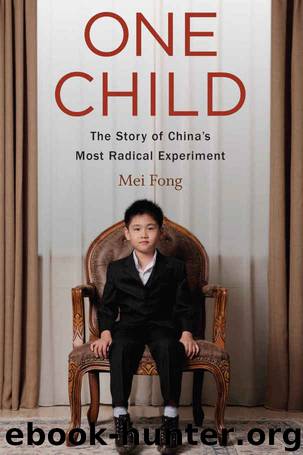One Child: The Story of China's Most Radical Experiment by Mei Fong

Author:Mei Fong [Fong, Mei]
Language: eng
Format: epub, azw3, mobi
Publisher: Houghton Mifflin Harcourt
Published: 2015-11-03T07:00:00+00:00
III
The one group that has substantially benefited from the one-child policy is urban Chinese females. If you are a female born after 1980 in a major Chinese city, your chances of surviving past childhood, getting enough nutrition, and attaining higher education are significantly better than those of a Chinese daughter born in any earlier period this century or last.
Only-child females, especially, who didn’t have brothers to compete with for parental resources, were the beneficiaries of the very pragmatic Chinese strategy of “raising a daughter as a son” (guniang dang erzi yang), notes anthropologist Vanessa Fong. As a result, record numbers of women in China are receiving a college education. In 2010, women made up half of the master’s degree students in China. The country’s female labor force participation is among the highest in Asia, with 70 percent of Chinese women either employed in some capacity or seeking employment, compared to just a quarter of their Indian sisters, according to Gallup.
But it’s hard to make the case that the one-child policy advanced Chinese women’s rights when, balanced against urban women’s advancements, one considers the huge numbers of females killed at birth or abandoned, as well as aborted female fetuses. Nobel Prize–winning economist Amartya Sen estimates that infanticide and gendercide have contributed to a missing 100 million women in Asia. Roughly half of those would have been Chinese.
With the current gender imbalance, women are certainly more valuable, but not necessarily more valued. In addition to a rising anti-feminist backlash, the female shortage has resulted in increasing commodification of women. Prostitution and sex trafficking in China have been on the rise for the past decade, though nobody has precise figures, for enforcement is lax and transparency low. In 2007, the US State Department estimated that a minimum of ten to twenty thousand victims are trafficked domestically within China yearly, earning traffickers more than $7 billion annually, more than selling drugs or weapons.
While it’s possible to argue that the one-child policy benefited some women in China, it’s certainly been detrimental to women in bordering countries such as Vietnam, Cambodia, Myanmar, and North Korea, where trafficking and kidnapping of women for Chinese men have risen in recent years. Many are forced or tricked into being sold as wives for Chinese men. Unlike the runaway brides of New Peace, most are unable to run away or, having escaped, face worse treatment. Chinese law tends to treat victims of sex trafficking as offenders, and there is very little in the way of shelters and support for these victims. Some, like North Korean women, if caught, are deported, where they face internment or death. According to the human rights organization Durihana Association, the bulk of the estimated fifty to one hundred thousand North Korean refugees in China are women sold for about $1,500 per head.
Perhaps the creepiest example I witnessed of China’s increasing commodification of women came when I visited a sex doll factory in Dongguan, the same city where authorities shut down the most extreme of the Confucius workshops.
Download
One Child: The Story of China's Most Radical Experiment by Mei Fong.azw3
One Child: The Story of China's Most Radical Experiment by Mei Fong.mobi
This site does not store any files on its server. We only index and link to content provided by other sites. Please contact the content providers to delete copyright contents if any and email us, we'll remove relevant links or contents immediately.
| Africa | Americas |
| Arctic & Antarctica | Asia |
| Australia & Oceania | Europe |
| Middle East | Russia |
| United States | World |
| Ancient Civilizations | Military |
| Historical Study & Educational Resources |
The Rape of Nanking by Iris Chang(3535)
The Sympathizer by Viet Thanh Nguyen(3531)
World without end by Ken Follett(3017)
Ants Among Elephants by Sujatha Gidla(2933)
Blood and Sand by Alex Von Tunzelmann(2617)
Japanese Design by Patricia J. Graham(2567)
City of Djinns: a year in Delhi by William Dalrymple(2141)
Inglorious Empire by Shashi Tharoor(2108)
In Order to Live: A North Korean Girl's Journey to Freedom by Yeonmi Park(2064)
Foreign Devils on the Silk Road: The Search for the Lost Treasures of Central Asia by Peter Hopkirk(2064)
Tokyo by Rob Goss(2025)
India's Ancient Past by R.S. Sharma(1994)
India's biggest cover-up by Dhar Anuj(1993)
The Great Game: On Secret Service in High Asia by Peter Hopkirk(1966)
Tokyo Geek's Guide: Manga, Anime, Gaming, Cosplay, Toys, Idols & More - The Ultimate Guide to Japan's Otaku Culture by Simone Gianni(1953)
Goodbye Madame Butterfly(1942)
The Queen of Nothing by Holly Black(1773)
Living Silence in Burma by Christina Fink(1738)
Batik by Rudolf Smend(1726)
